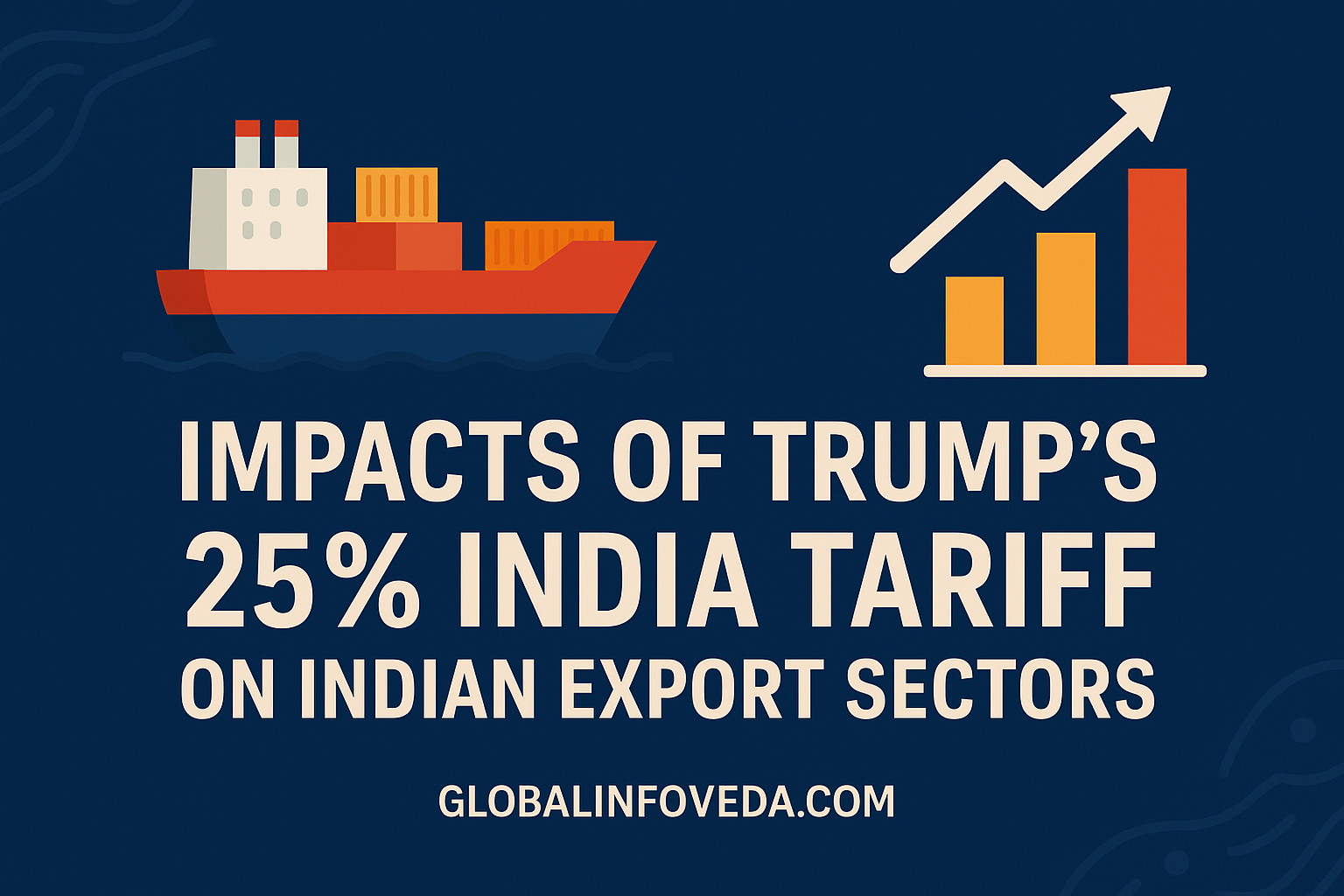Trump’s 25% India Tariff on Indian Export Sectors
In a surprising and polarizing move in mid-2025, former U.S. President Donald Trump—campaigning on an aggressive protectionist platform—announced a 25% blanket tariff on all Indian exports to the United States. Though still awaiting Congressional ratification, the announcement has sent tremors through Indian manufacturing hubs, global supply chains, and investment circles. The tariff, framed as a “Fair Trade Restoration Measure,” is seen by many economists as a strategic and geopolitical tool aimed at discouraging overreliance on foreign production and pressuring U.S. firms to reshore operations.
Even before formal implementation, the ripple effects are being felt across trade corridors, with cancelled orders, frozen inventory, volatile currency movements, and renewed attention to trade diversification.
📉 Which Indian Sectors Are Hit the Hardest?
1. Textiles & Apparel
India’s textile sector, employing over 45 million people, is one of the nation’s most export-reliant industries, with the U.S. as its largest market.
Major Consequences:
- Surat, Tirupur, Ludhiana, and Panipat garment exporters report production rollbacks and deferred hiring
- Mid-sized exporters operating on thin margins face closures due to unsustainable cost absorption
- Retailers like Target and Kohl’s have suspended forward purchase agreements, waiting for clarity
- Likely redirection of U.S. retail contracts to Bangladesh, Cambodia, and Turkey
Sector Forecast: Losses could exceed $6.5 billion over the next 12 months if the tariff stands.
2. Pharmaceuticals
As the “pharmacy of the world,” India exports over $8 billion in generics to the U.S. annually.
Critical Challenges:
- Complex regulatory re-approvals may be needed under new tariff-linked clauses
- Non-tariff barriers (NTBs) like compliance audits and added documentation further raise costs
- Hyderabad and Ahmedabad-based SMEs have already begun seeking EU and Middle East buyers
Public Health Note: Experts warn the U.S. may face a short-term spike in healthcare costs if Indian generics are restricted.
3. Automotive Components
India exports about $2 billion annually in auto components to the U.S., especially in the EV and hybrid segment.
Likely Effects:
- Tesla and Ford may shift procurement of charging modules and battery casings to Mexico or China
- SME vendors in Chennai, Hosur, Pune, and Rajkot are preparing for layoffs
- Domestic component stockpiles risk expiration or repurposing delays
4. IT Services (Indirect Impact)
While software and digital services are largely unaffected by tariffs directly, sentiment and investment trends play a huge role.
Secondary Consequences:
- American clients are freezing large-scale BPO contracts in anticipation of policy retaliation
- Startups in Bengaluru and Noida report reduced venture capital interest from U.S.-based investors
- Companies like TCS and Infosys have triggered internal reviews of U.S.-centered operations
Market Reaction: Infosys stock dipped 6.7% and Wipro dropped 5.1% post-announcement.
📦 Supply Chain Disruptions & Trade Diversion
U.S.-India shipping volumes are facing their steepest downturn since the pandemic. The evolving tariff climate is reshaping supply chain decisions.
Operational Impact:
- Indian ports (especially Nhava Sheva, Mundra, and Visakhapatnam) reported 8–14% fewer container departures for U.S. in June–July 2025
- Large exporters are renegotiating freight contracts and incurring demurrage charges due to stalled shipments
- Alternative trade corridors to Africa, LATAM, and EU are seeing uptick in B2B export inquiries
Customs Delay Insight: U.S. ports have begun preemptive scanning and clearance reclassifications of Indian-origin cargo.
🏛️ Policy & Diplomatic Reactions
India’s response has been swift and multidimensional:
Diplomatic Countermeasures:
- A formal complaint filed with WTO challenges the legality under Most Favored Nation (MFN) rules
- India is fast-tracking Free Trade Agreements (FTAs) with the UK, EU, and Australia to cushion dependency
- High-level dialogues initiated between India’s External Affairs Ministry and USTR (U.S. Trade Representative)
Domestic Support Initiatives:
- The Commerce Ministry is proposing a ₹25,000 crore Export Buffer Corpus
- SEZ units are being considered for enhanced duty drawback rates
- Government exploring credit easing and fiscal support for high-employment sectors like textiles and pharma
📊 What Can Exporters Do Now?
✅ Diversify & De-risk:
- Proactively develop presence in less saturated regions: Africa, Southeast Asia, Eastern Europe
- Apply for inclusion in India-UAE CEPA, India-EFTA and India-MERCOSUR fast-track initiatives
✅ Build Digital Trade Resilience:
- List on export-oriented e-marketplaces like IndiaMART Global, Alibaba Pro+, Global Sources
- Invest in multi-lingual digital brochures and auto-quote systems for fast pivoting to new geographies
✅ Explore Trade Innovation:
- Seek trade credit insurance and AI-powered tariff navigation tools that calculate new pricing models
- Build micro-brands that position offerings within exempted product categories (e.g., IP-protected, low carbon, medical-grade)
✅ Community & Policy Advocacy:
- Join industry collectives such as FIEO, EEPC, Pharmexcil to voice concerns at policy and global platforms
- Collaborate with diaspora lobbies in U.S. states like California, Texas, and Illinois where trade-friendly senators hold sway
🌍 Global Perspective: Will Others Follow?
- EU and Canada are watching closely—experts warn of a protectionist domino effect
- ASEAN may benefit as a near-term substitute for U.S. procurement
- China, surprisingly, has remained neutral—likely due to its own fragile trade truce with Washington
- International banks and insurers have already recalibrated India-U.S. export credit ratings
🧠 Final Insight
Whether this tariff becomes law or political theatre, its shadow looms large. For Indian exporters, the takeaway is clear: U.S.-centric dependence is a strategic risk.
In 2025 and beyond, global exporters must cultivate multi-market agility, robust compliance practices, and localized manufacturing where possible.
India’s trade future will depend not just on price and volume—but on resilience, innovation, and alliance-building.
🌐 Stay informed on global trade, economics, and policy at GlobalInfoVeda.com
